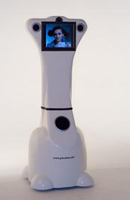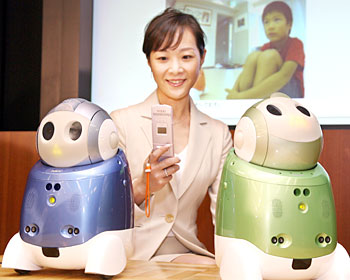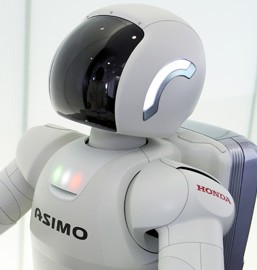Apr 11, 2007
MOBI

Graham Smith is a leading expert in the fields of telepresence, virtual reality, videoconferencing and robotics. He has worked with leading Canadian high tech companies for more than 14 years, including Nortel, Vivid Effects, VPL, BNR and IMAX. Graham initiated and headed the Virtual Reality Artist Access Program at the world-renowned McLuhan Program at the University of Toronto, and has lectured internationally. He holds numerous patents in the field of telepresence and panoramic imaging, and was recognized in Macleans magazine as one of the top 100 Canadians to watch.
23:05 Posted in AI & robotics, Telepresence & virtual presence | Permalink | Comments (0) | Tags: robotics, artificial intelligence, telepresence
Mar 16, 2007
Socially assistive robotics for post-stroke rehabilitation
Journal of NeuroEngineering and Rehabilitation
Maja J Matari
Background: Although there is a great deal of success in rehabilitative robotics applied to patient recovery post stroke, most of the research to date has dealt with providing physical assistance. However, new rehabilitation studies support the theory that not all therapy need be hands-on. We describe a new area, called socially assistive robotics, that focuses on non-contact patient/user assistance. We demonstrate the approach with an implemented and tested post-stroke recovery robot and discuss its potential for effectiveness. Results: We describe a pilot study involving an autonomous assistive mobile robot that aids stroke patient rehabilitation by providing monitoring, encouragement, and reminders. The robot navigates autonomously, monitors the patient's arm activity, and helps the patient remember to follow a rehabilitation program. We also show preliminary results from a follow-up study that focused on the role of robot physical embodiment in a rehabilitation context. Conclusion: We outline and discuss future experimental designs and factors toward the development of effective socially assistive post-stroke rehabilitation robots.
21:46 Posted in AI & robotics | Permalink | Comments (0) | Tags: robotics, artificial intelligence
Robot/computer-assisted motivating systems for personalized, home-based, stroke rehabilitation
21:45 Posted in AI & robotics | Permalink | Comments (0) | Tags: robotics, artificial intelligence
Feb 25, 2007
Grand challenges proposed by the U.K. Computing Research Committee
Re-blogged from KurzweilAI.net
Grand challenges proposed by the U.K. Computing Research Committee include a project to unify cognitive science, artificial intelligence, and robotics.
One sign of success would be a robot capable of functioning at the level of a 2- to 5-year-old child. Another milestone could be a robot capable of autonomously helping a disabled person around a house without explicit preprogramming about its environment.
Other challenge is intended to create more dependable computers and associated software systems, which oversee the bulk of the world's financial transactions, regulate life-saving instruments, and manage the delivery of products.
Read Original Article>>
12:18 Posted in AI & robotics, Research institutions & funding opportunities | Permalink | Comments (0) | Tags: artificial intelligence, robotics
Socially assistive robotics for post-stroke rehabilitation
Socially assistive robotics for post-stroke rehabilitation
By Maja J Mataric', Jon Eriksson, David J Feil-Seifer and Carolee J Winstein, Journal of NeuroEngineering and Rehabilitation
Background: Although there is a great deal of success in rehabilitative robotics applied to patient recovery post-stoke, most of the rehabilitation research to date has dealt with providing physical assistance. However, new studies support the theory that not all therapy need be hands-on. We describe a new area, called socially assistive robotics, that focuses on non-contact patient/user assistance. We demonstrate the approach with an implemented and tested post-stroke recovery robot and discuss its potential for effectiveness. Results: We describe a pilot study involving an autonomous assistive mobile robot that aids stoke patient rehabilitation by providing monitoring, encouragement, and reminders. The robot navigates autonomously, monitors the patient's arm activity, and helps the patient remember to follow a rehabilitation program. We also show preliminary results from a follow-up study that studied the role of robot physical embodiment in a rehabilitation context. Conclusions: Future experimental design and factors that will be considered in order to develop effective socially assistive post-stroke rehabilitation robot are outlined and discussed.
03:36 Posted in AI & robotics, Cybertherapy | Permalink | Comments (0) | Tags: robotics, cybertherapy
Jan 24, 2007
Robotics and virtual reality
Robotics and virtual reality: a perfect marriage for motor control research and rehabilitation.
Assist Technol. 2006;18(2):181-95
Authors: Patton J, Dawe G, Scharver C, Mussa-Ivaldi F, Kenyon R
This article's goal is to outline the motivations, progress, and future objectives for the development of a state-of-the-art device that allows humans to visualize and feel synthetic objects superimposed on the physical world. The programming flexibility of these devices allows for a variety of scientific questions to be answered in psychology, neurophysiology, rehabilitation, haptics, and automatic control. The benefits are most probable in rehabilitation of brain-injured patients, for whom the costs are high, therapist time is limited, and repetitive practice of movements has been shown to be beneficial. Moreover, beyond simple therapy that guides, strengthens, or stretches, the technology affords a variety of exciting potential techniques that can combine our knowledge of the nervous system with the tireless, precise, and swift capabilities of a robot. Because this is a prototype, the system will also guide new experimental methods by probing the levels of quality that are necessary for future design cycles and related technology. Very important to the project is the early and intimate involvement of therapists and other clinicians in the design of software and its user interface. Inevitably, it should also lead the way to new modes of practice and to the commercialization of haptic/graphic systems.
23:02 Posted in Cybertherapy, Virtual worlds | Permalink | Comments (0) | Tags: virtual reality, robotics
Biofeedback for robotic gait rehabilitation
22:59 Posted in Biofeedback & neurofeedback | Permalink | Comments (0) | Tags: biofeedback, robotics, rehabilitation
Jan 15, 2007
The University of Washington Neural Systems Lab have created a humanoid robot you can control with your thoughts.
![]() Via Mind Hacks
Via Mind Hacks





 Researchers at the University of Washington Neural Systems Lab have created a humanoid robot you can control with your thoughts via a EEG-based non-invasive brain-computer interface.
Researchers at the University of Washington Neural Systems Lab have created a humanoid robot you can control with your thoughts via a EEG-based non-invasive brain-computer interface.
Link to Neural Systems Lab robot info page



20:52 Posted in Brain-computer interface | Permalink | Comments (0) | Tags: brain-computer interface, artificial intelligence, robotics
Jan 07, 2007
Scientists have designed and built an immersive table tennis simulation that allows a human to compete against a computer
Via KurzweilAI.net
Scientists have designed and built an immersive table tennis simulation that allows a human to compete against a computer..
23:19 Posted in AI & robotics | Permalink | Comments (0) | Tags: artificial intelligence, robotics
Dec 30, 2006
Evolved Virtual Creatures
Via Suicide Bots
From the Evolved Virtual Creatures website
This video shows results from a research project involving simulated Darwinian evolutions of virtual block creatures. A population of several hundred creatures is created within a supercomputer, and each creature is tested for their ability to perform a given task, such the ability to swim in a simulated water environment. Those that are most successful survive, and their virtual genes containing coded instructions for their growth, are copied, combined, and mutated to make offspring for a new population. The new creatures are again tested, and some may be improvements on their parents. As this cycle of variation and selection continues, creatures with more and more successful behaviors can emerge.
The creatures shown are results from many independent simulations in which they were selected for swimming, walking, jumping, following, and competing for control of a green cube.
Download movie from the Internet Archive
swimming
13:35 Posted in AI & robotics | Permalink | Comments (0) | Tags: artificial intelligence, robotics
Dec 22, 2006
Recent trends in robot-assisted therapy environments
Recent trends in robot-assisted therapy environments to improve real-life functional performance of affected limbs.
J Neuroengineering Rehabil. 2006 Dec 18;3(1):29
Authors: Johnson MJ
ABSTRACT: Upper and lower limb robotic tools for neuro-rehabilitation are effective in reducing motor impairment but they are limited in their ability to improve real world function. There is a need to improve functional outcomes after robot-assisted therapy. Improvements in the effectiveness of these environments may be achieved by incorporating into their design and control strategies important elements key to inducing motor learning and cerebral plasticity such as mass-practice, feedback, task-engagement, and complex problem solving. This special issue presents nine articles. The novel strategies covered in this issue encourage more natural movements through the use of virtual reality and real objects and faster motor learning through the use of error feedback to guide acquisition of natural movements that are salient to real activities. In addition, several articles describe novel systems and techniques that use of custom and commercial games combined with new low-cost robot systems and a humanoid robot to embody the supervisory presence of the therapy as possible solutions to exercise compliance in under-supervised environments such as the home.
00:13 Posted in AI & robotics, Cybertherapy | Permalink | Comments (0) | Tags: artificial intelligence, robotics, cybertherapy
Dec 18, 2006
Researchers demonstrate EEG control of humanoid robot
Via ScienceDaily
University of Washington researchers have developed a brain-computer interface that allows humans to control the actions of robots through commands generated by analysis of EEG signals
Link
17:32 Posted in AI & robotics, Brain-computer interface | Permalink | Comments (0) | Tags: brain-computer interface, robotics
Nov 11, 2006
Computer- and robot-aided head surgery
Computer- and robot-aided head surgery.
Acta Neurochir Suppl. 2006;98:51-61
Authors: Wörn H
In this paper new methods and devices for computer and robot based head surgery are presented. A computer based planning system for CMF-surgery allows the surgeon to plan complex trajectories on the head of the patient for operations where bone segments were cut out and shifted. Different registration methods have been developed and tested. A surgical robot system for bone cutting on the head has been developed and evaluated at the patient in the operating theatre. In future, laser cutting of bones with a robot will be seen as a new powerful method for robot based surgery. A 3D augmented reality system will assist the surgeon in the future by augmenting virtual anatomical structure into the situs.
16:18 Posted in AI & robotics | Permalink | Comments (0) | Tags: robotics, cybertherapy
Nov 01, 2006
HAL
Via Engadget

HAL (short for Hybrid Assistive Limb) is a robotic suite designed "to expand and improve physical capabilities of human being".
The system, a brainchild of Yoshiyuki Sankai, engineering professor at Tsukuba University, is getting ready for mass production, Engadget reports. The robotic suite could be used in applications such as "walking assistance and rehabilitation, nursing, factory work and disaster relief."
HAL is originally developed to help elderly or disabled people walk around with their own legs and HAL-3 achieved the primary goal in 2000.In 2005, the latest model HAL-5 was given upper body limbs as well as weight saving and more compact POWER units, longer life battery and much smaller control unit and spectacularly designed outer shells.
HAL is a robot suit which can expand and improve physical capabilities of human being. By wearing HAL-5 and you can hold up to 40 kg load by arms and can increase the maximum weight of leg press from 100 kg to 180 kg.
Read more at Engadget
22:20 Posted in AI & robotics, Cybertherapy | Permalink | Comments (0) | Tags: artificial intelligence, robotics, cybertherapy
Oct 30, 2006
Vision-body link tested in robot experiments
Re-blogged from KurzweilAI.net
"Embodied cognition" experiments involving real and simulated robots suggest that the relationship between physical movement and sensory input could be crucial to developing more intelligent machines...
Read the full article
14:46 Posted in AI & robotics | Permalink | Comments (0) | Tags: artificial intelligence, robotics
Oct 27, 2006
PaPeRo Robot Childcare In Japan
Via Technovelgy
NEC and NTT have jointly produced PaPeRo (short for Partner-type Personal Robot), the latest of a series of domestic robots. PaPeRo uses a camera in each eye to navigate and has image recognition capabilities to track and identify individual children. Further, it is equipped with a mobile phone that allows parents to control him at distance, as well as to talk to children directly or with text messages

22:02 Posted in AI & robotics | Permalink | Comments (0) | Tags: artificial intelligence, robotics
Vision-body link tested in robot experiments
Tests involving real and simulated robots suggest the relationship between physical movement and sensory input could be crucial to create smarter machines...
Read the full story
22:01 Posted in AI & robotics | Permalink | Comments (0) | Tags: artificial intelligence, robotics
Oct 11, 2006
Robotic Whiskers Can Sense Three-Dimensional Environment
Re-blogged from Robots.net

© 2006 Northwestern University
Two Northwestern University engineers have developed an array of robotic whiskers that sense in two dimensions, mimicking the capabilities of mammalian whiskers. The bending moment, or torque, at the whisker base is then used to calculate the three-dimensional features of solid objects.
Read the full story here
21:34 Posted in AI & robotics | Permalink | Comments (0) | Tags: robotics
Oct 06, 2006
fMRI-compatible rehabilitation hand device
| Background: Functional magnetic resonance imaging (fMRI) has been widely used in studying human brain functions and neurorehabilitation. In order to develop complex and well-controlled fMRI paradigms, interfaces that can precisely control and measure output force and kinematics of the movements in human subjects are needed. Optimized state-of-the-art fMRI methods, combined with magnetic resonance (MR) compatible robotic devices for rehabilitation, can assist therapists to quantify, monitor, and improve physical rehabilitation. To achieve this goal, robotic or mechatronic devices with actuators and sensors need to be introduced into an MR environment. The common standard mechanical parts can not be used in MR environment and MR compatibility has been a tough hurdle for device developers. Methods: This paper presents the design, fabrication and preliminary testing of a novel, one degree of freedom, MR compatible, computer controlled, variable resistance hand device that may be used in brain MR imaging during hand grip rehabilitation. We named the device MR_CHIROD (Magnetic Resonance Compatible Smart Hand Interfaced Rehabilitation Device). A novel feature of the device is the use of Electro-Rheological Fluids (ERFs) to achieve tunable and controllable resistive force generation. ERFs are fluids that experience dramatic changes in rheological properties, such as viscosity or yield stress, in the presence of an electric field. The device consists of four major subsystems: a) an ERF based resistive element; b) a gearbox; c) two handles and d) two sensors, one optical encoder and one force sensor, to measure the patient induced motion and force. The smart hand device is designed to resist up to 50% of the maximum level of gripping force of a human hand and be controlled in real time. Results: Laboratory tests of the device indicate that it was able to meet its design objective to resist up to approximately 50% of the maximum handgrip force. The detailed compatibility tests demonstrated that there is neither an effect from the MR environment on the ERF properties and performance of the sensors, nor significant degradation on MR images by the introduction of the MR_CHIROD in the MR scanner. Conclusions: The MR compatible hand device was built to aid in the study of brain function during generation of controllable and tunable force during handgrip exercising. The device was shown to be MR compatible. To the best of our knowledge, this is the first system that utilizes ERF in MR environment. |
09:50 Posted in AI & robotics, Research tools | Permalink | Comments (0) | Tags: robotics, cybertherapy
Oct 02, 2006
Japan to invest US$17.4 million in robotics research
|
Japan’s Ministry of Economy, Trade and Industry (METI) will invest over 2 billion yen (US$17.4 million) to support the development of intelligent robots that rely on their own decision-making skills in the workplace. The objective of METI’s robot budget is to support the development of key artificial intelligence technology for robots over the next 5 years, with the goal of introducing intelligent robots to the market by 2015. |
11:00 Posted in AI & robotics, Research institutions & funding opportunities | Permalink | Comments (0) | Tags: artificial intelligence, robotics








